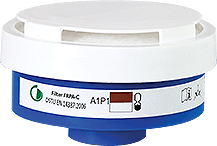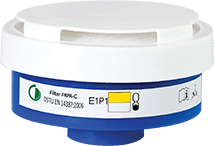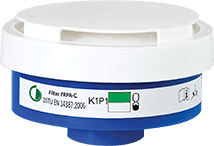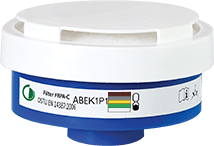Highly efficient activated and impregnated carbons, which absorb gases, vapors and smells.
Sorbent corrosion activity in relation to the filter casing is excluded.
The filter design allows using the absorbing resource of the sorbent fully, replacing the removable preliminary filter, blocked by dust, with a new one.
The plastic filter casing is made of impact-resistant polymer.
Filter casing material does not cause spark formation that is important when working in an atmosphere with a high organic and inorganic gases and vapors concentration (СН4, H2S, Н2, petroleum derivatives, HNO3 synthesis and others).
It is not deformed and the dents are not formed during mechanical action, gas penetration is excluded.
It is made of the ‘ELEFLEN’ non-woven filtering materials.
A removable cover for fastening of preliminary filter.
Clamp seal
Sorbent agent. Highly efficient activated and impregnated carbons, which absorb gases, vapors and smells. Sorbent corrosion activity in relation to the filter casing is excluded. The filter design allows using the absorbing resource of the sorbent fully, replacing the removable preliminary filter, blocked by dust, with a new one.
Casing. The plastic filter casing is made of impact-resistant polymer. Filter casing material does not cause spark formation that is important when working in an atmosphere with a high organic and inorganic gases and vapors concentration (СН4, H2S, Н2, petroleum derivatives, HNO3 synthesis and others). It is not deformed and the dents are not formed during mechanical action, gas penetration is excluded.
Preliminary filter. It is made of the ‘ELEFLEN’ non-woven filtering materials.
Cover. A removable cover for fastening of preliminary filter.
Application and Instructions
The FRPA-C combined filters are intended for air cleaning from vapour and gaseous harmful substances and aerosols.
The FRPA-C combined filters are used at gases (vapour) concentration up to 0.1% of volume (1000 ppm) and aerosols content up to 4 MPC.

FRPA-C А1Р1 filter

FRPA-C E1Р1 filter

FRPA-C K1Р1 filter

FRPA-C АВЕK1Р1 filter
Certification
The FRPA-C combined filters comply with ‘Technical Regulations for Personal Protective Equipment’, approved by the Decree No. 761 of the Cabinet of Ministers of Ukraine, August 27, 2008.
They are certified in the UkrSEPRO system.
They have a conclusion of National sanitary-epidemiological expertise at Ministry of Health Care in Ukraine.

